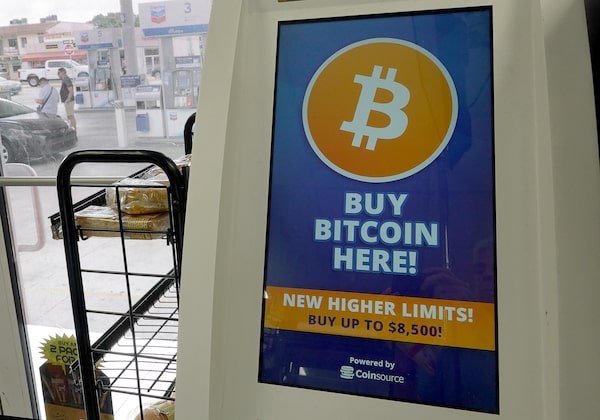A deluge of data from across major economies comes at a pivotal moment in the debate over whether central banks are jacking up interest rates into a potentially sharp global growth slowdown.
And with jittery investors dumping risk assets en masse, what comes next after a crypto-currency rout is also in focus.
Here’s your week ahead in markets:
HARD OR SOFT LANDING?
Traders work as Federal Reserve Chair Jerome Powell is seen delivering remarks on a screen at the New York Stock Exchange (NYSE) on March 16.BRENDAN MCDERMID/Reuters
The Federal Reserve is all but certain to hike interest rates by 50 basis points at upcoming meetings. Upcoming data should show whether hefty tightening will bring a hard or soft landing for the economy.
Forecasts for Tuesday’s U.S. retail sales data predict a 0.7% rise in April after a 0.5% monthly increase in March. Signs of how much inflation, which shows only the slightest hints of moderating, is pinching consumers may also be evident in Tuesday’s earnings reports from Walmart, Home Depot and Macy’s.
Friday’s existing home sales data could show just how quickly rising mortgage rates are cooling the housing market.
The Fed’s determination to contain inflation has fuelled hard landing worries. The S&P 500 is set for its worst year since 2008 -- any signs the economy is weathering higher rates would be welcome relief.
CRYPTO CRASH

A cryptocurrency ATM setup in a convenience store on May 1 in Miami.Joe Raedle/Getty Images
Cryptocurrency aficionados and observers alike will be watching for the fallout of a spectacular price collapse.
Bitcoin was on track on Friday for a double-digit weekly drop, and headed for a record losing streak. Other cryptocurrencies have also slid with investors shunning risk assets as central banks get aggressive on inflation.
Whether so-called stablecoins can maintain their dollar pegs as investor confidence plummets is key. The algorithmic stablecoin TerraUSD broke its peg and has plunged to as low as 30 cents, as its complex balancing mechanism involving another free-floating token stopped working.
Others such as Tether, USD Coin and Binance USD are confident they will be spared TerraUSD’s fate because their cryptocurrencies are backed by reserves of dollar-based assets. Those reserves may come under increasing scrutiny as investors assess whether those coins can handle a wave of redemptions.
TAKING ASIA’S PULSE
A shopper wearing a protective mask pushes a shopping cart at Japan's supermarket group Aeon's shopping mall as the mall reopens amid the coronavirus disease (COVID-19) outbreak in Chiba, Japan May 28, 2020.KIM KYUNG-HOON/Reuters
A data pulse across Asia could re-calibrate the outlook for regional assets.
Japan reports growth, trade and inflation data. If they beat expectations, even the world’s most dovish central bank may start considering a more neutral stance -- good news for a frail yen.
China reports industrial output, retail sales and house prices, probably all glum. China also fixes benchmark rates, though traders see steady as the most likely outcome.
And in Australia, wages and jobs figures are out. Its central bank didn’t wait for the data before hiking rates on May 3 and markets suspect further increases are coming. Rates are expected to be near 3% by year-end, any signs to the contrary could prompt an unwind of expectations.
WHAT SPENDING POWER?

A customer shops in a Walmart store during Black Friday on Nov. 26, 2021 in Houston.Brandon Bell/Getty Images
The consumer is in trouble. Soaring food and fuel prices are eroding disposable incomes and lockdown-era savings that could have been spent on travel and shopping, are dwindling fast.
Economists predict COVID curbs will have driven a 6% slump in China’s April retail sales, almost double March falls. U.S. April retail sales are tipped to rise, but as in March, gasoline and food may account for most of the increase.
British consumer confidence slumped in March to near the lowest in nearly half a century, research firm GfK said. A cost-of-living squeeze likely deepened shoppers’ gloom in April.
No surprise global consumer discretionary shares have tumbled almost a third this year, exceeding a broader equity index fall . Investors have taken note; several say they are no longer banking on the consumer.
PIPELINES & PAYMENTS

The Astora underground natural gas storage facility stands on May 12 in Rehden, Germany. Russia has announced sanctions against dozens of western energy companies, including Gazprom Germania, of which Astora is a subsidiary.David Hecker/Getty Images
Pressures on Europe’s gas markets show no sign of abating.
Moscow’s sanctions against Gazprom Germania, in which its gas producer Gazprom ceded ownership, and EuRoPol GAZ SA, owner of the Polish part of the Yamal-Europe gas pipeline, have sent prices higher. A Kremlin decree from May 3 bans Russian entities to make deals with those on the sanctions list.
This has hit flows to Europe already diminished after Ukraine declared force majeure and said it will not reopen a key gas transit route from Russia to Europe until Kyiv obtains full control over its pipeline system.
And there’s still confusion among EU gas companies over a payment scheme decreed by Moscow in March that the European Commission has said would breach EU sanctions as deadlines approach.
Be smart with your money. Get the latest investing insights delivered right to your inbox three times a week, with the Globe Investor newsletter. Sign up today.